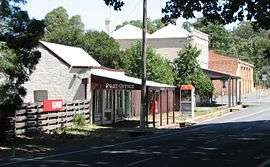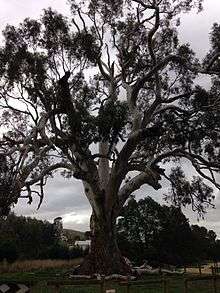Guildford, Victoria
| Guildford Victoria | |||||||||||||
|---|---|---|---|---|---|---|---|---|---|---|---|---|---|
 | |||||||||||||
 Guildford | |||||||||||||
| Coordinates | 37°09′0″S 144°09′0″E / 37.15000°S 144.15000°ECoordinates: 37°09′0″S 144°09′0″E / 37.15000°S 144.15000°E | ||||||||||||
| Population | 245 (2011 census)[1] | ||||||||||||
| Postcode(s) | 3451[2] | ||||||||||||
| Location |
| ||||||||||||
| LGA(s) | Shire of Mount Alexander | ||||||||||||
| |||||||||||||
Guildford is a small settlement situated on the Loddon River, 130 kilometres (81 mi) north-west of Melbourne, in Victoria, Australia. It is located on the Midland Highway between Daylesford and Castlemaine. The population recorded at the 2011 census was 245.[1]
Facilities in the town include a post office (in a building dating from 1901), hotel, community hall and a general store.[3]
It is thought that the town was named after Guildford in England.[3]
Big Tree

The Big Tree is a large, well-preserved River Red Gum (Eucalyptus camaldulensis), located at the corner of Fryers Street and Ballarat Street. It is thought to be one of the largest in Victoria, with a height of 34 metres and circumference of 9.35 metres at the base. The tree is estimated to be over 500 years old.[4]
History
The area was known as Yarrayne to the original inhabitants of the area, the Jajowarrung people. The first European to explore the area was Major Thomas Mitchell in 1836.[3]
By the 1840s pastoral runs had been established and, in the following decade, gold miners flocked to the area during the rush at the Mount Alexander goldfields. The largest encampment of Chinese miners in Victoria (estimates vary from 5000-6000 individual miners) was situated at the junction of the Loddon River and Campbells Creek. Tensions ran high between the white miners and the Chinese which erupted in numerous local conflicts.[3] This anti-Chinese hostility, combined with discriminatory taxation against Chinese miners, saw the Chinese population dwindle and eventually all but disappear by the end of the gold rush.[5]
The first hotel opened in 1854 but was destroyed by fire three years later. The Guildford Family Hotel which also dates back to this era is still operational today. Other hotels in the town included the Farmers Arms Hotel (delicenced) and the Commercial Hotel (1865), the building now serving as a general store.[3]
A school was built and a Post Office opened [6] in 1860, followed by the Anglican Church the following year. The Catholic Church and the Wesleyan Chapel are now both private property.[3]
In 1919 an avenue of honour was planted along the main road, using London Planes, to commemorate locals who fought in World War I.[3]
Panorama
Guildford panorama
References
- 1 2 Australian Bureau of Statistics (25 October 2007). "Guildford (State Suburb)". 2006 Census QuickStats. Retrieved 2008-01-14.
- ↑ Australia Post postcode search
- 1 2 3 4 5 6 7 "Guildford". Travel. The Age. 2004-02-08. Retrieved 2008-01-14.
- ↑ "Eucalyptus camaldulensis". National Trust of Australia - Victoria. Retrieved 2007-01-14.
- ↑ Chinese at the Australian Goldfields "http://www.kidcyber.com.au/topics/goldchinese.htm" Retrieved 04-09-2011
- ↑ Premier Postal History. "Post Office List". Retrieved 2008-04-11.
External links
![]() Media related to Guildford, Victoria at Wikimedia Commons
Media related to Guildford, Victoria at Wikimedia Commons
- Place Names Search: Guildford Geoscience Australia